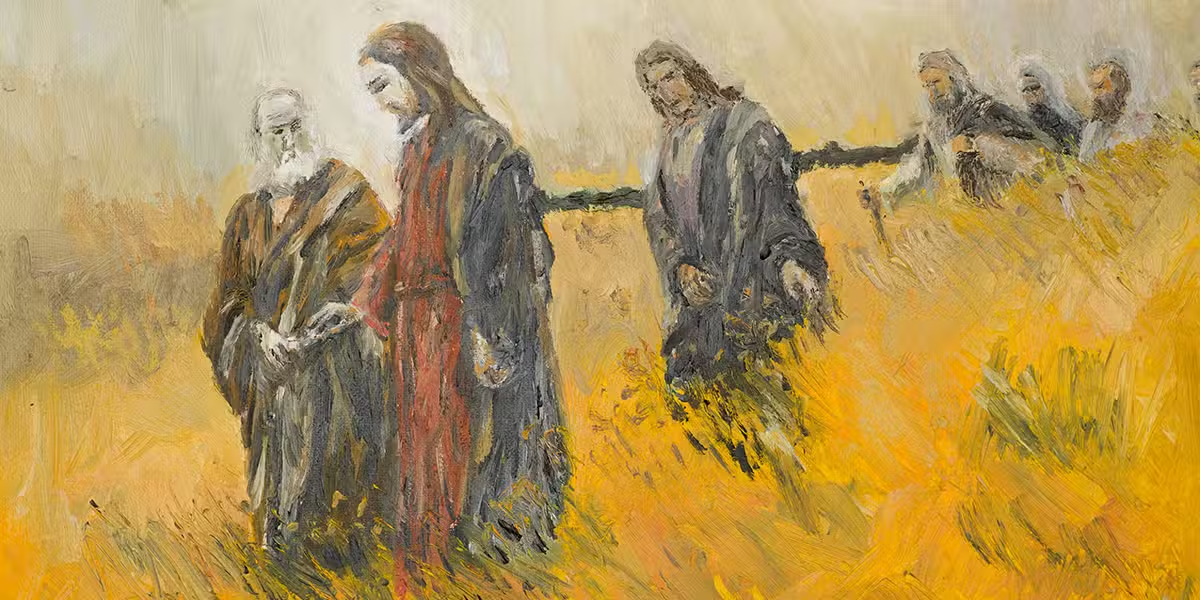This scholar takes a look at the environment that helped shape salvation.
The Incarnation of the Word of God took place in the land of Israel (also known as Palestine) 2,000 years ago. This includes the same geographical area we hear and read about in the daily news from the Middle East: Jerusalem, Bethlehem, Galilee, the West Bank. Jesus lived his entire life in this part of the world.
Because of Jesus’ presence and that of many other biblical figures, it is often referred to as the “Holy Land.” Those who visit the Holy Land will inevitably hear it described as “the Fifth Gospel.” Such a visit can contribute greatly to our appreciation of Jesus as a historical figure and a Jew.
Setting the Stage
The Holy Land is relatively small, about the size of Massachusetts or New Jersey. The northern area, with the Sea of Galilee and the Jordan River at its eastern border, is called Galilee; this was Jesus’ home for most of his life. The central portion is Samaria, and the southern section is known as Judea. The capital of Judea and the center of Jewish religious practice in Jesus’ time was Jerusalem, the place where Jesus was put to death.
During Jesus’ adult life, Galilee was ruled by Herod Antipas, one of the sons of Herod the Great. Judea was overseen directly by the Roman prefect or governor, Pontius Pilate, between 26 and 36 A.D. It was in this geographical and historical context that Jesus lived and worked. The Romans served as protectors for the Judeans from the mid-second century B.C. onward. However, by the first century A.D. they had integrated Palestine into the empire and taken direct political control of Judea.
Jesus’ Birth and Upbringing
The major sources about Jesus’ birth and upbringing are the infancy narratives in Matthew 1—2 and Luke 1—2. Because they combine historical facts, biblical interpretations and theology, they are especially challenging for modern historians to deal with.
A special difficulty is posed by the evangelists’ independent references to the virginal conception of Jesus. It is clear that Mary of Nazareth was the mother of Jesus, and her husband Joseph was the legal father of Jesus. But according to the Gospels of Matthew and Luke, the child Jesus was conceived “from the Holy Spirit.” The rules of strict modern historical scholarship do not allow for divine interventions in human affairs or for unique cases. But the Gospels present Jesus both as a divine being and as unique among humankind.
Historians today often try to explain away the virginal conception of Jesus as an example of the “birth of the hero” myth or as a cover story for Jesus’ illegitimate birth. But the parallels from other ancient texts are not convincing, and the rumors of Jesus’ illegitimacy more likely reflect early Christian affirmations of his virginal conception. So we are left with the fact that the only ancient sources we have independently state that Jesus was miraculously conceived through the power of the Holy Spirit.
Matthew and Luke also agree that Jesus was born in Bethlehem, near Jerusalem. Matthew gives the impression that Mary and Joseph had been living there already, while Luke explains that they traveled from Nazareth to Bethlehem so that Joseph, as a descendant of David, could be registered in his ancestral home as part of a Roman governmental census.
The place of Jesus’ birth contributes to his identity as the Messiah (Mt 2:6) and as the Son of David. While some historians consider this to be all too neat and even possibly invented for theological purposes, again the only ancient sources we have agree independently that Jesus was born in the town of Bethlehem.
Jesus’ Family
According to Mark 6:3 and Matthew 13:55-56, Jesus had four “brothers” named James, Joses (or Joseph), Judas and Simon, as well as several “sisters.” Since the second and third centuries these “brothers” and “sisters” have been explained in various ways—as full siblings of Jesus, as Joseph’s children from an earlier marriage, or as relatives (possibly cousins) who lived in the same area. The first explanation conflicts with the Church’s doctrine of Mary’s perpetual virginity, while the other two do not.
No one doubts that Jesus was raised in Nazareth in Galilee. That town did not have a distinguished history. We get a hint of this in John’s Gospel when Nathanael, one of Jesus’ first disciples, asked, “Can anything good come out of Nazareth?” (1:46).
According to Mark, Jesus worked as a tekton, usually translated as “carpenter” but probably meaning something broader like a general construction worker whose skills included carpentry. Matthew states that Jesus was the son of a carpenter. Both Joseph and Jesus may have worked on the elaborate buildings recently excavated at Sepphoris, not far from Nazareth.
Jesus, the Jew
Luke’s infancy narrative affirms that Jesus had a traditional Jewish upbringing. He was circumcised and named on the eighth day after his birth. Forty days after his birth he was “presented” at the Jerusalem Temple in keeping with the Jewish Law. At the age of 12 he made a Passover pilgrimage to the Temple with his parents. John’s Gospel indicates that Jesus made other pilgrimages as an adult in addition to the final pilgrimage that led to his death.
That Jesus participated in worship at the synagogue in Nazareth is clear from several Gospel accounts. Mark, Matthew and Luke portray him as reading the Scriptures in public and teaching there. The embarrassing fact that the people of his hometown rejected him serves as a guarantee of the event’s historical foundation. This is not the kind of story that early Christians might invent.
First-Century Judaism
Jews in Jesus’ time were united by three great institutions: the Jerusalem Temple, the land of Israel and the Law of Moses. Within that framework there were different ways of being a Jew.
- The Pharisees were a lay movement that sought to extend the Temple purity rules to all Jews and emphasized common meals featuring religious discussion.
- The Sadducees were a more conservative group that by Jesus’ time had gained influence over the Temple and its priesthood.
- The Essenes stressed community life and asceticism. Likely they were the people behind the Dead Sea scrolls. These were ancient manuscripts discovered in the late 1940s that were the remnants of the library of a Jewish religious sect usually identified as the Essenes.
- The Zealots were an activist group that engaged in armed resistance against the Roman occupiers.
- And there were end-time visionaries, scribes, chief priests, tax collectors and “sinners” (Jews who by choice or occupation, such as pig-keepers, did not observe all of the Jewish Law).
Jesus’ Place in Judaism
Where does Jesus fit on this map of Jewish groups and movements? On the one hand, Jesus has been described as a “marginal Jew” in a book of the same name by John P. Meier on the grounds that he defies any specific categorization. On the other hand, the scholar N. T. Wright portrays him in Jesus and the Victory of God as the incarnation of his people Israel and all its hopes.
We can say with some confidence that Jesus lived as an observant Jew; his quarrel was with the traditions attached to the Law. We can also say that among the various Jewish groups he was closest to the Pharisees in that they shared interest in such topics as resurrection, Sabbath observance and the relative importance of ritual purity, and entered into debate with them. What is beyond any doubt is that Jesus had some connection with the movement begun by John the Baptist.
The Ministry of John the Baptist
According to Luke’s infancy narrative, John was born to Zechariah and Elizabeth in their old age, and was a relative of Jesus through Mary. Luke notes that when John grew up “he was in the wilderness” before he began his public ministry. That wilderness would have been the Judean Desert, where the Dead Sea scrolls were discovered in 1947. If there is any direct connection between Jesus and the Dead Sea scrolls, it would most likely have come about through John the Baptist.
The Jewish historian Flavius Josephus provides a brief description of John the Baptist in his Jewish Antiquities, in a passage not modified by Christian scribes. Josephus describes John as “a good man” who urged his fellow Jews to practice virtue, to act justly and to show piety toward God.
He also referred to John’s distinctive rite of baptism in connection with repentance and forgiveness of sins. He attributed John’s execution under Herod Antipas to Herod’s fear that John’s growing popularity might result in some kind of rebellion.
According to the Gospels, John proclaimed the coming Kingdom of God in connection with his rite of baptism. Receiving John’s baptism was a sign of one’s willingness to turn one’s life around and to prepare for the divine judgment that will accompany the full coming of God’s Kingdom.
Jesus and John
That Jesus underwent John’s baptism is another well-established fact. Since John’s baptism was associated with “repentance for the forgiveness of sins,” this was not something that early Christians would have created.
It is also likely that John the Baptist served as a mentor to Jesus, one who to some extent guided Jesus, especially with regard to his vision of the coming Kingdom and how to prepare for it.
Yet eventually Jesus went his own way. Whereas John adopted an ascetic and world-denying lifestyle, Jesus celebrated festive meals and preached to all kinds of people. Whereas John emphasized the future coming of God’s Kingdom, Jesus also stressed its present dimensions. And whereas John preached moral renewal as a way to get ready for God’s judgment, Jesus invited sinners to throw themselves on the grace and mercy of God.
John’s Followers become Jesus’ Disciples
In John’s Gospel we read that the first two disciples of Jesus came to him on the recommendation of John the Baptist from within his own circle of followers (1:35-42). When he saw Jesus walk by, John said, “Look, here is the Lamb of God.” One of the two disciples was Andrew, who then brought his brother, Simon Peter, to Jesus.
Mark tells a somewhat different story. Simon and Andrew encounter Jesus while doing their work as commercial fishermen by the Sea of Galilee. When Jesus says to them, “Follow me and I will make you fish for people,” they immediately drop everything and go with him (1:16-18). While prospective Jewish students usually sought out a teacher, here the teacher calls the prospective students and they come. The lack of prior contact and preparation makes the story all the more dramatic. The reader naturally wonders why these businessmen would give up their livelihood and family life to join in the mission of Jesus merely on the strength of his command “Follow me.” Mark’s version thus highlights the personal charisma of Jesus.
Jesus’ first followers eventually became part of the group of the Twelve, the inner circle among Jesus’ disciples and the symbol of the renewed Israel (recalling the 12 tribes of ancient Israel). It was their privilege to be with Jesus and to share in his mission and ministry. Although the first disciples often misunderstood Jesus and even fled when he was arrested, they served as principals of continuity between the public activity of the earthly Jesus and the formation of the early Church.
On the historical level there is very likely something to the connection between the disciples of John the Baptist and the first followers of Jesus. It is also likely that Jesus’ first followers already shared something of his hope for and dedication to the Kingdom of God.








